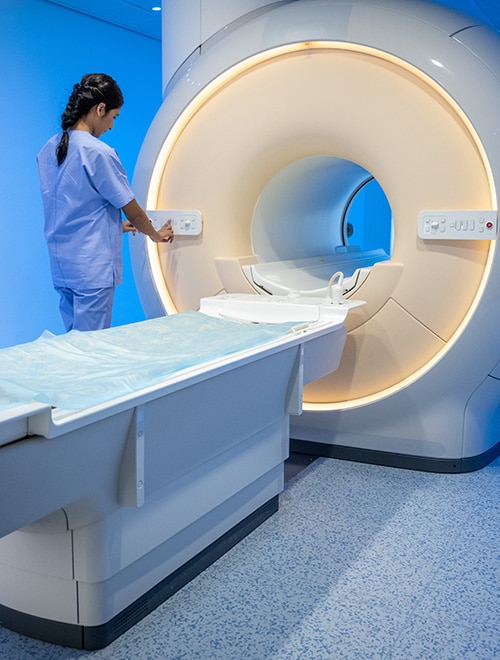- 4 min read
PSMA Therapy is a type of theranostics
Theranostics is a new and emerging field of nuclear medicine for prostate cancer detection and treatment. It combines the testing (also called diagnostics) with the therapy. This allows your doctor to see where the cancer has spread to in your body then target it with a radioactive molecule to kill the cancer cells.
The type of theranostics used in Australia for prostate cancer is called PSMA Therapy.
The aim of PSMA Therapy is to extend your life and improve your quality of life. It does this by slowing the growth of cancer cells and shrinking the cancer and by improving prostate cancer symptoms such as pain and fatigue.
Theranostics = therapy + diagnostics
What is PSMA Therapy?
PSMA Therapy is a two-step procedure:
- Diagnosis – a PSMA PET/CT scan is used to locate prostate cancer cells wherever they are in the body. Your doctor will let you know if you need any additional tests to determine if PSMA Therapy is suitable for you. Follow these links to learn more about PSMA PET/CT and The Role of PSMA PET/CT.
- Therapy – a radioactive compound attached to PSMA is used to find and kill the cancer cells.
A radioactive material currently being used in Australia is lutetium-177. When attached to PSMA and injected into your blood, this material (177Lu-PSMA) can find prostate cancer cells in your body and stick to them. Once stuck to the cancer cells, the radiation travels up to 2 millimetres killing the cell it is attached to and neighbouring cells. But as it does not travel far, there is little damage to nearby healthy tissues.
Who can have PSMA Therapy?
PSMA therapy is not suitable for everyone, it depends on the type of prostate cancer you have. You may need to have additional tests to work out if your type of cancer is likely to respond to PSMA Therapy. Ask your doctor if PSMA Therapy is suitable for you.
Clinical trials for PSMA Therapy using 177Lu-PSMA have concentrated on men with metastatic castration-resistant prostate cancer (mCRPC) – an advanced prostate cancer that has spread beyond the prostate gland and cannot be slowed or stopped by hormone therapy.
PSMA therapy is still being researched and has not yet been approved by the Therapeutic Goods Administration so it is not yet available as a conventional treatment. It can be accessed by joining a clinical trial and provided with little or no cost to you.
Alternatively, you might be able to have PSMA Therapy through the Special Access System which is a way to access unapproved treatments. In this case there will be significant costs involved.
Ask your doctor if PSMA Therapy is suitable for you, how you can access the treatment and what costs are involved.
What is involved in PSMA Therapy?
PSMA Therapy is usually given as an outpatient treatment in a hospital or cancer centre, which means you don’t have to stay overnight. Treatments are given every 6 weeks and you may need up to 6 treatments. The treatment is managed by a nuclear medicine physician and a radiation nurse. They will talk to you about the radioactive compound you will be given, how often you need it and how many treatments you will need.
The treatment, 177Lu-PSMA, is injected into your arm through a cannula (a thin piece of plastic tubing inserted into a vein in your arm). The treatment takes about 15-20 minutes. After treatment you will be given fluids through the cannula and your radiation levels will be monitored. It can take up to 3 hours for the radiation in your body to drop to a safe level so you can go home. For safety reasons, you cannot take anyone with you when you are being treated.
The day after your treatment, you will need to go back to the clinic for a PSMA PET/CT scan to see if the treatment was effective. You will also meet with your nuclear medicine specialist to talk about your results. Make sure you ask questions about your treatment and results. You might find it helpful to take your partner or a loved on with you to this appointment.
You will also have blood tests before starting and during treatment to keep check on your blood cell count. This treatment can put you at risk of a low blood cell count, which can lead to anaemia, infections and bruising.
What do you need to know about your radiation safety and side effects?
After your treatment, you will be given radiation safety instructions to follow when you are at home as you will have low levels of radiation in your body (including urine and bowel movements). The radiation levels will decrease each day for about a week. Read the instructions to make sure you understand them before you leave the clinic. Make sure you ask questions if you need to as it is important for your safety and that of your family that you follow the instructions.
PSMA Therapy, like other forms of prostate cancer treatment, is likely to impact your fertility. Speak to your doctor or healthcare team before starting treatment if loss of fertility is a concern for you.
There are also some side effects with this treatment. These include, dry mouth, fatigue (tiredness), nausea, anaemia, infections and bruising. However, clinical trials of PSMA Therapy suggest that it is better tolerated than chemotherapy.
Read about the side effects of PSMA Therapy.
Potential impact on future prostate cancer detection and treatment
PSMA Therapy has shown promising results in prostate cancer trials and has the potential to have a major clinical impact on the diagnosis and treatment of prostate cancer, especially in those with aggressive forms of prostate cancer. Clinical trials are underway with more research needed to fully understand the effectiveness of this therapy.
If you have any questions about PSMA Therapy reach out to a PCFA nurse on 1800 22 00 99.
Key points
- Theranostics, is an emerging therapy for advanced prostate cancer, especially aggressive forms, such as metastatic castration-resistant prostate cancer (mCRPC)
- Theranostics in prostate cancer, called PSMA Therapy, combines treatment with diagnostics at the same time – an example is the use of a PSMA PET/CT scan with a radioactive material
- Lutetium-177 is the main radioactive material being studied in prostate cancer theranostics
- Clinical trials into PSMA Therapy for prostate cancer are ongoing – it has the potential to have a major impact on clinical management of prostate cancer in the future






